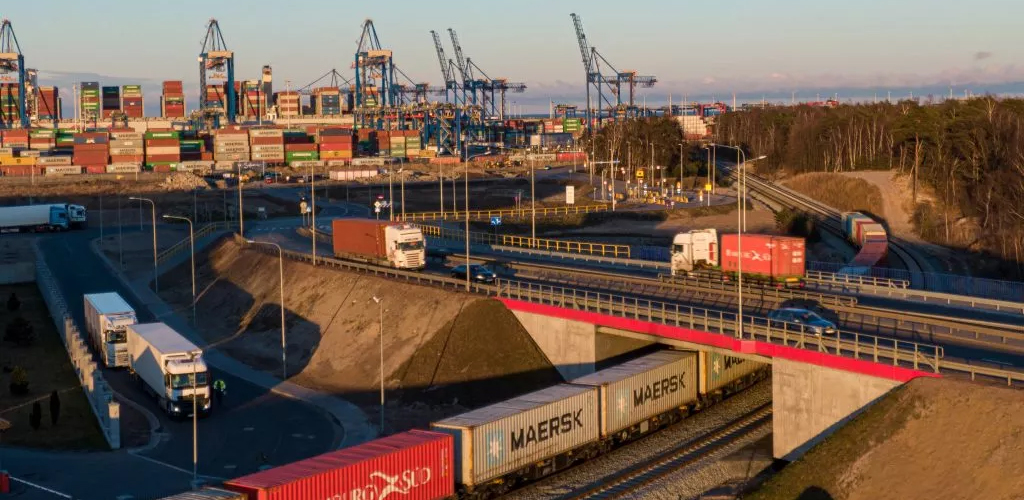Mar 24 | 2021
Road, Rail Project Part of Major Investment

The Port of Gdańsk Authority SA is putting the finishing touches on a major investment project to construct new roads and track system leading from the PKP Port Północy railway station to the gates of individual terminals.
The port authority contracted with Sopot-based NDI for the PLN 166 million (€34 million) project. It included a buffer part for trucks, 10 kilometers of tracks, 14 railroad switches, seven engineering structures, including road viaducts and culverts along the PERN and LOTOS fuel pipelines, the port authority said. The first trucks rolled along the target road system on Kontenerowa Street on March 17.
“We have implemented this project with our current and future customers in mind so that their reloading process processes are as efficient as possible,” said Łukasz Greinke, port authority president.
Road-Rail Accessibility
The DCT terminal, the largest in the region of the Baltic Sea, will have two dedicated tracks, while the road project will create “collision-free traffic” from the terminal to the south of Poland, Greinke explained.
“Two dedicated two-plus-two roadways to the container terminal will ensure the container exit’s compliance with the highest European standards,” he said. “Our project fits perfectly into projects implemented by the General Directorate for National Roads and Motorways, which are coordinated at the government level by the Ministry of Infrastructure. The A1 motorway linking the Czech Republic with the Polish coast of the Baltic Sea and the Port of Gdańsk is already 85 percent complete. In 2022, we will be able to travel directly and without traffic lights from the Port of Gdańsk to Ostrava in the Czechia, Brno, Prague, and Slovak Bratislava.”
Work at the project started in August 2018, with main construction work completed in 2020, and is down to clean-up and acceptance works, the port authority said.
The Outer Port’s road and rail system expansion project involved rebuilding the streets Portowa, Poinca, Kontenerowa, and Budowniczych Portu Północnego. Four new viaducts were erected, and two existing ones dismantled, including one over operable railway tracks and the other over the PERN, LOTOS, and Naftoport fuel pipeline complex. A new track to the DCT terminal has been added, as well as new tracks to coal terminals, and a modern railway traffic control system. Also, a buffer car park for trucks, the first in this part of the port, has been built, the port authority said.
NDI Challenges
“The biggest challenge in this project was logistics,” said Maciej Szymański, NDI site manager. “On many occasions, the work was carried out 24 hours a day to, for example, restore train traffic to the DCT terminal as soon as possible. We carried out the works in almost all disciplines and we always had to maintain the port’s ability to operate normally.” This was possible due to cooperation with the port and contract engineer SWECO, Szymański added.
The last few months have been for finishing works and paving works on Kontenerowa Street. Overall, the builders used 40,000 tons of bituminous mass, 13,000 cubic meters of structural concrete, 860 tons of reinforcing steel, and 1,200 tons of rails.
This project benefits not only the DCT container terminal, but impacts “the enormous scope for the entire Outer Port area, which is responsible for the majority of reloading in the Gdańsk port, said Lech Paszkowski, director of the development and investment part at the Port of Gdańsk.
What’s Next
This project is part of the largest capital expenditure program at the Port of Gdańsk since the late 1970s, valued at more than PLN 750 million (€163 million). And yet, the Port of Gdańsk is not slowing down.
Plans include further upgrades and development of quays, as well as road and rail infrastructure, ultimately totalling more than PLN 1 billion (€217 million) of port infrastructure capital expenditure, Paszkowski said.
Port of Gdańsk is the Titanium Sponsor for Breakbulk Europe, which moves to the Rotterdam Ahoy, May 17-19, 2022.


